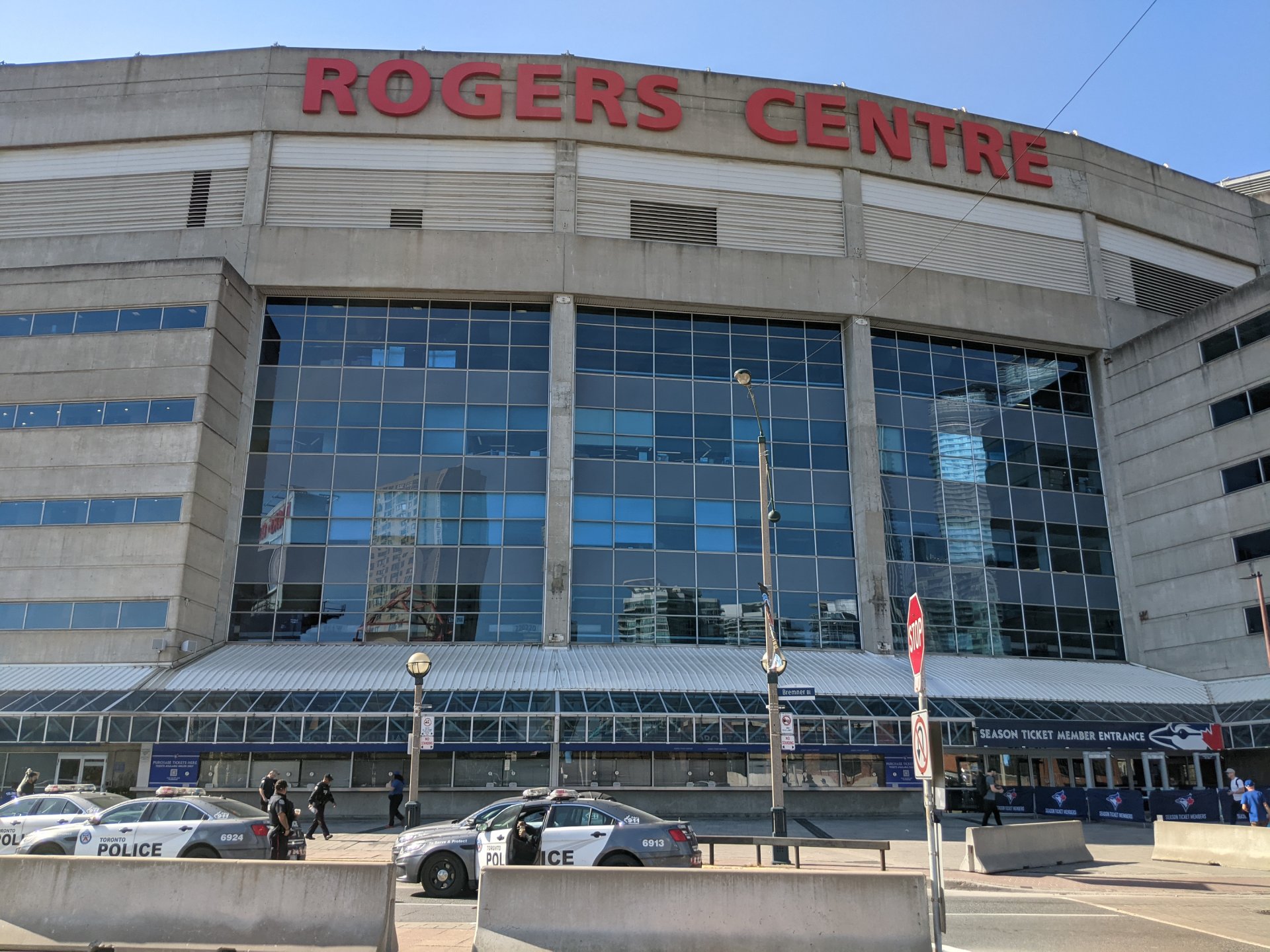
Rogers Centre, previously known as the SkyDome, opened for business in 1989. Since the Blue Jays’ inception in 1977, the team had played at the outdoor Exhibition Stadium, which was an outdated Canadian football stadium with a location close enough to Lake Ontario that weather — rain, high winds, fog and even snow — was often an issue. (If you’re up on Canadian baseball trivia, you’ll know that the Jays’ inaugural game had a lengthy snow delay.) Additionally, because of the size of a Canadian Football League field, the facility wasn’t ideal for hosting baseball. When converted for the Jays, many sections of seating were extremely far from home plate. After years of chanting, “We want a dome!” fans finally got their wish. Construction on the $570-million SkyDome began in 1986 and the Jays played their first game there on June 2, 1989.
The stadium was renamed Rogers Centre in 2005, soon after Rogers Communications bought the facility. (And, if you’re curious, it’s “Rogers Centre,” not “The Rogers Centre.”) In the months that followed the renaming, Rogers put significant money toward upgrading the video board, changing the turf and renovating the 100 Level. The turf upgrade meant that the AstroTurf, which had been in place since 1989, was lifted and replaced with FieldTurf. Rogers Centre’s FieldTurf lasted from 2005 to 2010 before being once again upgraded, this time to AstroTurf Gameday Grass. The field at Rogers Centre is symmetrical — 328 feet to the corners, 375 feet in the power alleys and 400 feet to straightaway center field.
The Blue Jays aren’t the only tenant of Rogers Centre. They share the facility with the NFL’s Buffalo Bills during their Toronto home games and the CFL’s Toronto Argonauts. The stadium has also played host to every sort of event from evangelical religious ceremonies to monster truck shows. The largest attendance in the building’s history was in 2002, when 68,237 fans attended Wrestlemania 18. For baseball, Rogers Centre has a capacity of 49,260.
Regardless of where you sit, you’ll be able to enjoy Rogers Centre’s enormous video board, which is one of the stadium’s signature sights. Although the facility was equipped with a JumboTron (the largest in the world at the time) when it was built, the Blue Jays upgraded to a modern Daktronics video board in time for the 2005 season. The screen, which measures 33 feet by 110 feet, uses LED technology and has impressive viewing angles. Despite the enormity of the screen, it’s still significantly smaller than the notable video board in Cleveland’s Progressive Field, which measures 36 feet by 149 feet. The stadium’s main scoreboard isn’t the only place to follow the game, however. Rogers Centre has a pair of screens built into the outfield fence that each measure 10 feet by 65 feet. These screens provide player stats, out-of-town scores and other information related to the game and league. Finally, Rogers Centre has a continuous, ribbon-style video board on the facing of the 300 Level, providing stats and scores.
When you’ve found your seat, you’ll find it hard not to stare at the roof, especially if you haven’t previously visited Rogers Centre. The roof, which was the first of its kind in the world, is comprised of three panels that move on a set of tracks and one panel that is stationary. The roof’s total area is 339,343 square feet, has a weight of 11,000 tons and the motor that slides the panels generates 750 horsepower. The Jays endeavor to play with the roof open as much as possible to provide fans with a traditional baseball experience. When the panels are open, the entire field and 91 percent of the seats are exposed to the sky above. If you’re lucky, you’ll get to see the roof open and shut during your visit. The entire process takes roughly 20 minutes.
Rogers Centre commemorates past Blue Jays on its Level of Excellence, which is located between the third and fourth decks in the outfield. The names on the display include former players Roberto Alomar, George Bell, Joe Carter, Tony Fernandez and Dave Stieb, former manager Cito Gaston, executives Pat Gillick and Paul Beeston and longtime broadcaster Tom Cheek. While you’re in the mood for nostalgia, look above the video board for the team’s American League East banners, World Series banners and banners recognizing 2011 National Baseball Hall of Fame inductees Alomar and Gillick.
An impressive feature of Rogers Centre is the Renaissance hotel, which bills itself as the “world’s only four-diamond hotel located in a major league sports and entertainment venue.” The 11-floor, 313-room hotel has 70 field-facing rooms situated above and beside the stadium’s video board. Although the field-facing rooms are pricy, they give you the ability to watch batting practice and other on-field sights before the stadium’s gates open.
Rogers Centre offers hour-long tours from March 1 to October 31. Between March 1 and May 31, tours take place three times a day — 11 a.m., 1 p.m. and 3 p.m. From June 1 to October 31, tours run on the hour between 11 a.m. and 4 p.m. Tours begin inside Gate 3 and cost $16 for adults, $12 for seniors and youth between 12 and 17 years of age and $10 for children 11 or under. In addition to focusing on the baseball side of Rogers Centre, the tour also includes information and memorabilia from concerts and other events held in the stadium. The tour takes you to different levels of Rogers Centre and also passes through the press box and a luxury suite.
Rogers Centre Photos
You must be logged in to post a comment.